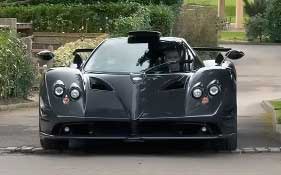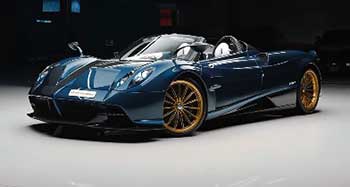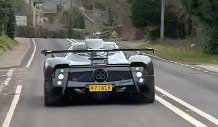
As a car enthusiast, I’ve always been captivated by the artistry and performance of Pagani’s creations.
In this article, I’ll take you through my firsthand experience comparing the Pagani Zonda and Huayra, two hypercars that define automotive passion.
From their breathtaking designs to their exhilarating drives, I’ll explore their pros, cons, and maintenance needs, offering a clear comparison to help you understand what makes each special.
Whether you’re a collector or simply curious, join me in uncovering which masterpiece might steal your heart.
Comparison Table
| Feature | Pagani Zonda | Pagani Huayra |
|---|---|---|
| Debut Year | 1999 | 2011 |
| Engine | 7.3L Naturally Aspirated V12 (AMG) | 6.0L Twin-Turbo V12 (AMG) |
| Horsepower | 547-750 hp (varies by model) | 730-850 hp (varies by model) |
| Top Speed | ~220 mph (354 km/h) | ~238 mph (383 km/h) |
| 0-60 mph | ~3.5 seconds | ~2.8 seconds |
| Transmission | 6-speed Manual | 7-speed Sequential |
| Weight | ~2,800 lbs (1,270 kg) | ~2,755 lbs (1,250 kg) |
| Production Run | ~140 units (all variants) | ~100 units (base model) |
| Price (Starting) | ~$1.4M (1999, adjusted) | ~$1.4M (2011, adjusted) |
| Aerodynamics | Fixed Aero Elements | Active Aerodynamics |
| Key Feature | Raw, visceral driving experience | Advanced tech with refined performance |
My Experience With Pagani Zonda
The first time I laid eyes on a Pagani Zonda, it felt like meeting a rock star. Its angular, aggressive lines screamed rebellion, and the roar of its naturally aspirated 7.3-liter AMG V12 was pure music. Driving it was an adrenaline rush—raw, unfiltered, and demanding.
The manual gearbox required skill, rewarding every precise shift with a surge of power. The carbon-fiber body felt alive, vibrating with every rev, making me feel connected to the road in a way few cars can. It’s a masterpiece of the late ’90s, embodying Horacio Pagani’s vision of art meeting performance.
The Zonda’s interior is a work of art. Leather, carbon fiber, and aluminum blend into a cockpit that feels like a bespoke suit. Every detail, from the Pagani-etched bolts to the exposed gear linkage, exudes craftsmanship. On the track, it’s a beast.
The handling is sharp, but it demands respect—lose focus, and it’ll remind you of its power. I took a Zonda Cinque around a circuit once, and its 678 horsepower felt like a wild stallion, barely tamed. The lack of modern aids like traction control made every corner a test of skill.
Yet, the Zonda isn’t perfect. Its age shows in the absence of modern tech, and the ride can feel harsh on public roads. Still, it’s a car that makes you feel alive, a rare gem that’s more about emotion than precision.
For collectors, its limited production—around 140 units across all variants—adds to its allure. Owning one feels like holding a piece of history, a reminder of when hypercars were about raw passion.
My Experience With Pagani Huayra

The Pagani Huayra, introduced in 2011, feels like the Zonda’s sophisticated sibling.
When I first drove one, its 6.0-liter twin-turbo V12 from Mercedes-AMG hit me with 730 horsepower, a smoother but no less thrilling power delivery than the Zonda.
The seven-speed sequential gearbox shifted with lightning precision, and the active aerodynamics—those four flaps adjusting in real-time—made it feel like the car was dancing with the road. Its top speed of 238 mph and 0-60 sprint in 2.8 seconds are mind-blowing, yet it’s surprisingly manageable.
The Huayra’s design is a step into the future. Its smoother, more aerodynamic shape contrasts with the Zonda’s sharp edges, and the gullwing doors add a theatrical flair. Inside, it’s a blend of luxury and tech, with a cabin that feels like a high-end watch.
The carbon-titanium monocoque chassis keeps it light at 2,755 pounds, and the attention to detail—like leather straps securing the rear clamshell—makes every glance a delight. On the road, it’s more refined, soaking up bumps better than the Zonda, yet it’s just as exhilarating on a track.
The Huayra’s tech, like its adjustable flaps and advanced ECU, makes it more forgiving than the Zonda. I drove a Huayra BC at Spa-Francorchamps, and its 791 horsepower and 1,102 pounds of downforce at 174 mph glued it to the corners.
But its complexity can feel less soulful than the Zonda’s rawness. With only 100 base units made, it’s as exclusive as its predecessor, but its modern engineering makes it a hypercar for a new era.
Also read: My Thoughts on Acura ILX Vs. Honda Accord
Pros Of Pagani Zonda
- Iconic Design: The Zonda’s angular, aggressive look is timeless, turning heads with its bold lines and classic hypercar stance.
- Raw Driving Experience: The naturally aspirated V12 and manual gearbox deliver a visceral, unfiltered connection to the road.
- Exclusivity: With only about 140 units produced, owning a Zonda feels like holding a rare piece of automotive art.
- Soundtrack: The 7.3-liter V12’s scream is one of the most intoxicating exhaust notes in the car world, especially in models like the Zonda F.
- Craftsmanship: Every detail, from carbon-fiber panels to hand-stitched leather, showcases Pagani’s obsession with perfection.
- Collector Value: Its cult following and limited production make it a strong investment, with prices soaring for variants like the Cinque.
- Simplicity: Lacking modern driver aids, it offers a pure, skill-driven experience that appeals to purists.
The Zonda’s charm lies in its rawness. It’s a car that demands your full attention, rewarding skill with an unmatched sense of achievement. Its design, unchanged much since 1999, feels like a love letter to the hypercar’s golden age.
The sound alone—reaching up to 9,000 rpm in the Zonda R—makes every drive an event. For collectors, its rarity and iconic status ensure it holds value, with some models fetching over $15 million at auctions. It’s not just a car; it’s a legacy that defined Pagani’s place in the automotive world.
Cons Of Pagani Zonda
- Outdated Technology: Lacking modern aids like traction control or adjustable suspension, it can feel primitive compared to newer hypercars.
- Harsh Ride: The stiff suspension and low ground clearance make it uncomfortable for daily driving or uneven roads.
- Maintenance Costs: Parts for the AMG V12 are expensive, and specialized service can cost tens of thousands annually.
- Limited Practicality: With minimal storage and a tight cabin, it’s impractical for anything beyond short drives or track days.
- Safety Concerns: No crash-test ratings and minimal safety features make it riskier than modern hypercars.
- Fuel Economy: Expect single-digit mpg, making it a gas-guzzler even by hypercar standards.
- Availability: Finding one is nearly impossible, and prices for well-maintained models are astronomical.
The Zonda’s age is its biggest drawback. Without modern tech, it can feel like a relic on public roads, where its stiff ride and lack of driver aids demand constant focus. Maintenance is a nightmare—sourcing parts for a car with such low production numbers is costly and time-consuming.
I once heard of a Zonda owner spending $50,000 on a single service, and that’s not uncommon. Its impracticality and poor fuel economy make it a car for special occasions, not daily use. For all its charm, it’s a demanding companion that requires deep pockets and deeper commitment.
Pros Of Pagani Huayra
- Advanced Aerodynamics: Four active flaps adjust for optimal downforce or drag, making it a cornering beast with up to 1.9 g of lateral grip.
- Refined Performance: The twin-turbo V12 delivers 730-850 horsepower with smoother power delivery, hitting 60 mph in 2.8 seconds.
- Luxurious Interior: The cabin blends carbon fiber, leather, and aluminum into a masterpiece of comfort and style.
- Modern Engineering: Features like a carbon-titanium chassis and advanced ECU make it lighter and more manageable than the Zonda.
- Versatility: It’s more comfortable on roads while still dominating on tracks, offering a broader driving appeal.
- Exclusivity: Limited to 100 base units, with special editions like the BC and Codalunga even rarer, ensuring collector appeal.
- Customization: Extensive options, from vibrant colors to bespoke interiors, let owners create a unique hypercar.
The Huayra feels like a leap into the future. Its active aero makes it feel alive, adjusting to every corner like a fighter jet. The twin-turbo V12, while less raw than the Zonda’s, delivers ferocious power with less effort, making it accessible yet thrilling.
I was blown away by the BC’s grip at Spa, where it felt glued to the track. The interior is a sensory delight, with details like the gear selector feeling like jewelry. Its versatility—comfortable on roads, lethal on tracks—makes it a hypercar you can live with more easily than the Zonda.
Also read: My Thoughts on Ford Edge Vs. Hyundai Tucson
Cons Of Pagani Huayra
- Less Soulful: The turbocharged engine lacks the Zonda’s naturally aspirated scream, feeling more clinical.
- Complex Maintenance: The advanced tech, like active aero and sequential gearbox, requires specialized, costly servicing.
- High Price: Starting at $1.4 million, with special editions like the Codalunga at $7.36 million, it’s a massive investment.
- Limited Production: With only 100 base units, finding one is tough, and special editions are even rarer.
- Fuel Economy: At 10 mpg city and 14 mpg highway, it’s not much better than the Zonda.
- Overly Complex: The tech-heavy design can feel less engaging for purists who prefer raw mechanics.
- Resale Competition: Newer hypercars like the Pagani Utopia may overshadow its long-term value.
The Huayra’s complexity is a double-edged sword. Its turbocharged V12, while powerful, misses the Zonda’s emotional howl. Maintenance is a headache—those active flaps and sequential gearbox require Pagani-trained technicians, and costs can soar.
I spoke to an owner who spent $80,000 on a single repair, a reminder of the car’s demanding nature. Its price, especially for limited editions, puts it out of reach for most, and the tech-heavy approach might alienate those who love the Zonda’s simplicity. Still, it’s a technological marvel that pushes boundaries.
Maintenance Tips For Pagani Zonda

- Regular Engine Checks: The AMG V12 needs frequent oil changes and inspections to maintain its 547-750 horsepower output; use only Pagani-approved fluids.
- Tire Maintenance: High-performance Pirelli P Zero tires wear quickly; check tread depth and pressure monthly to ensure grip.
- Carbon-Fiber Care: Clean the carbon-fiber body with non-abrasive products to preserve its finish; avoid harsh chemicals that could damage the weave.
- Specialized Servicing: Only Pagani-certified mechanics should handle repairs, as generic shops lack the expertise for this rare car.
- Store Properly: Keep the Zonda in a climate-controlled garage to prevent corrosion of aluminum and magnesium components.
- Transmission Care: The manual gearbox requires periodic clutch inspections; replace worn parts to maintain smooth shifts.
- Track Prep: Before track days, check brakes and suspension for wear, as the Zonda’s aggressive setup takes a beating.
Maintaining a Zonda is like caring for a priceless artifact. Its V12 demands meticulous attention—oil changes alone can cost $2,000 due to specialized fluids. I learned from a Zonda owner that skipping regular tire checks led to a $10,000 replacement bill after a track session.
The carbon-fiber body needs gentle cleaning to avoid scratches, and finding a certified mechanic is crucial, as only a handful exist globally. Storing it in a controlled environment prevents costly corrosion, and the manual gearbox requires careful handling to avoid clutch wear. Treat it like a living thing, and it’ll reward you with unforgettable drives.
Maintenance Tips For Pagani Huayra
- Aero System Checks: Inspect the active aerodynamic flaps regularly to ensure they move freely; malfunctions can cost thousands to fix.
- Turbo Maintenance: The twin-turbo V12 requires frequent checks for turbo lag and boost pressure; use Pagani-specified parts only.
- Interior Care: Clean leather and carbon-fiber surfaces with gentle products to maintain the cabin’s luxurious finish.
- Certified Servicing: Only Pagani-trained technicians should service the car, especially for complex systems like the sequential gearbox.
- Tire Monitoring: Pirelli P Zero Trofeo R tires need weekly pressure checks and alignment to handle the car’s 1.9 g cornering forces.
- Battery Maintenance: The advanced electronics demand a healthy battery; check and charge it regularly to avoid system failures.
- Climate Storage: Store in a dry, temperature-controlled garage to protect the carbon-titanium chassis from environmental damage.
The Huayra’s high-tech nature makes maintenance a precision task. Those active flaps, for instance, need regular testing—one owner I met faced a $15,000 repair bill when a flap motor failed. The twin-turbo V12 requires specialized diagnostics to keep its 730-850 horsepower flowing smoothly, and only Pagani-approved shops have the tools.
Tires wear fast under the car’s immense grip, so frequent checks are non-negotiable. The interior’s luxurious materials demand careful cleaning, and the electronics need a reliable battery to avoid glitches. A climate-controlled garage is a must to protect the chassis. It’s a high-maintenance masterpiece, but worth every effort.
Frequently Asked Questions (FAQ)
The Zonda, launched in 1999, uses a naturally aspirated V12 and manual gearbox, offering a raw, visceral drive. The Huayra, introduced in 2011, features a twin-turbo V12, sequential gearbox, and active aerodynamics for refined performance.
The Zonda doesn’t meet U.S. safety and emissions standards, lacking features like airbags and complying with EPA regulations. Some owners import it under the “Show or Display” exemption for non-road use.
It depends on taste. The Zonda offers raw, emotional driving, while the Huayra blends advanced tech with refinement. For purists, the Zonda Cinque; for tech lovers, the Huayra BC.
No, the Zonda’s price (starting at $1.4 million, up to $15 million for rare variants) is high but not the highest. Cars like the Bugatti Chiron Pur Sport or Rolls-Royce Boat Tail can exceed $20 million.
Conclusion: For Pagani Zonda And Huayra
You’ve joined me on a thrilling ride through the world of Pagani’s Zonda and Huayra, two hypercars that redefine performance and art. The Zonda’s raw, soul-stirring drive and iconic design make it a legend, perfect for those who crave unfiltered passion.
The Huayra, with its cutting-edge tech and refined power, offers a modern masterpiece for drivers seeking versatility. Both are rare, breathtaking, and demanding, but they cater to different souls. Which one calls to you? Whether you lean toward the Zonda’s rawness or the Huayra’s sophistication, you’re choosing automotive history.

